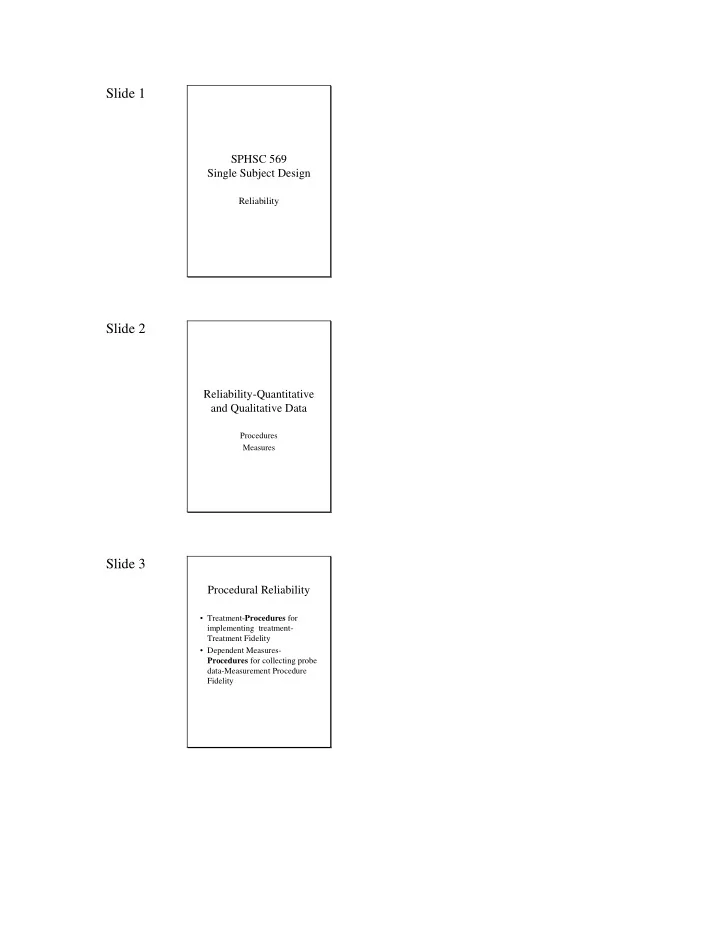

Slide 1 SPHSC 569 Single Subject Design Reliability Slide 2 Reliability-Quantitative and Qualitative Data Procedures Measures Slide 3 Procedural Reliability • Treatment- Procedures for implementing treatment- Treatment Fidelity • Dependent Measures- Procedures for collecting probe data-Measurement Procedure Fidelity
Slide 4 Fidelity of Treatment Delivery: Why Bother? • Improve treatment • Insure treatment integrity • Enhance clinical science Slide 5 Treatment Integrity The degree to which treatment is delivered as intended • Development of a treatment manual/protocol • Monitoring delivery of treatment as indicated in the manual – adherence-degree to which protocol is followed – competence-level of skill in which protocol is implemented Slide 6 Fidelity of Measurement Procedures: Why Bother? • Insure integrity of measurement procedures • Enhance clinical science • How far do you go? Standardized tests?
Slide 7 Fidelity of Measurement Procedures The degree to which probe procedures are delivered as intended • Development of a protocol • Monitoring delivery of protocol as indicated – adherence-degree to which protocol is followed – competence-level of skill in which protocol is implemented Slide 8 Procedural Reliability (Billingsley, White, & Munson, 1980) • Identify highlights/critical elements of delivery of procedures (create a template) – Deciding the critical elements • Instructions • Implementation • Have observer document the implementation of these critical elements • Examples Slide 9 Measurement Reliability Evaluation of agreement in recording/scoring data • Intra-observer agreement – What’s the purpose? – What’s the level of analysis? • Inter-observer agreement – What’s the purpose? – What’s the level of analysis? • Approaches – Issues (consider distribution of data and chance) – Overall agreement – Point - by - point – Correlation – Kappa – Alternatives
Slide 10 Occurrence/Correct Nonoccurrence/Incorrect Data • General Agreement and Point- by-point comparison • Each opportunity for a response can be scored as correct or incorrect (e.g., phoneme production) • Formula ( Handout) Slide 11 Categorical Data • Cohen’s Kappa (Cohen, 1960) • For data that are categorical. An opportunity for a response can be scored as two or more categories (not correct or incorrect) (e.g., semantic relations) • Formula (Handout) • Paradox – solutions (See references) Slide 12 Measurement Reliability Alternative Approaches • Visual Inspection - Plot data – Enough to see trends • Collection and agreement analysis different
Slide 13 Training Observers Keep track of procedures, sessions, hours at each step: • Practice coding together-work out bugs in the taxonomy, develop coding skills – video – on-line • Practice coding individually – compare/discuss • Practice/test coding individually • Final competency test (report % agreement) (Handout) Slide 14 Qualitative Data- (Lincoln & Guba, 1985) • Trustworthiness—”reality” is a multiple set of mental constructions • Truth Value—Demonstration that the multiple constructions have been represented adequately Slide 15 Qualitative Data- Trustworthiness • Credibility • Dependability • Confirmability
Slide 16 Credibility • Prolonged engagement • Persistent observation • Triangulation • Peer debriefing • Negative case analysis • Referential adequacy (verifying against archived “raw data) • Member Checking Slide 17 Dependability • Establish credibility (credibility leads to dependability) • Overlap methods (form of triangulation) • Stepwise replication--analogous to split-half mode of testing reliability--two inquiry teams as sources of data, conducting inquiries independently (daily or milestone points) • Inquiry audit--auditor of the process--protecting the stakeholders Slide 18 Confirmability • Inquiry audit--auditor of the product – triangulation • See Lincoln and Guba for a complete description of auditing
Recommend
More recommend